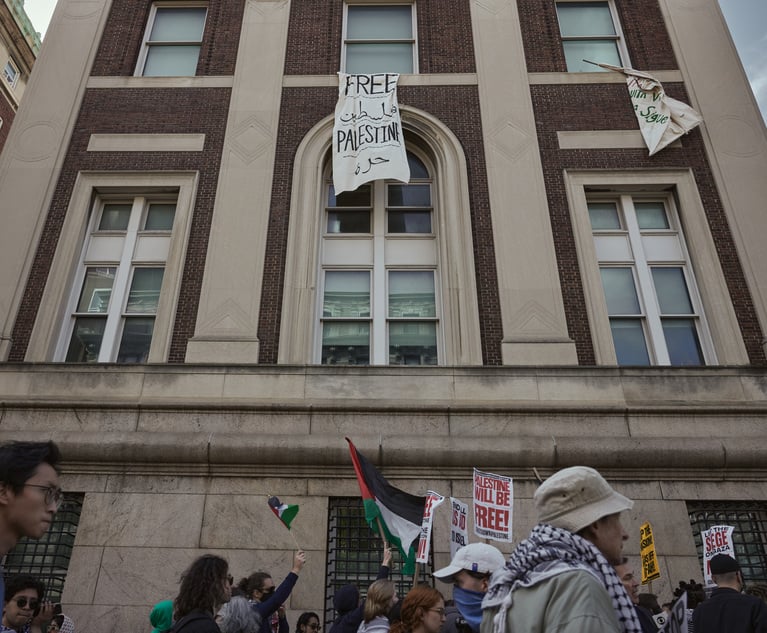 Apartment buildings in New York City. (Photo: Victor J. Blue/Bloomberg)
Apartment buildings in New York City. (Photo: Victor J. Blue/Bloomberg)'Yellowstone' Will Live on Through Creative Practitioners
While the commentators have bemoaned the court's decision (especially those representing tenants), the issue before us practitioners is what do we do when negotiating a lease and more specifically, the waiver of declaratory relief?
June 04, 2019 at 09:53 AM
4 minute read
I write in connection with the article appearing in the NYLJ of May 31, 2019, titled “'Yellowstone' No More.” Since the Court of Appeals decision in 159 MP Corp. v. Redbridge Bedford was handed down, there has been much talk amongst real estate litigation attorneys as to the impact of the decision and with regard to drafting these provisions.
Simply stated, under Redbridge, a tenant's waiver of declaratory judgment relief effectively waives the right to seek a Yellowstone Injunction, as long as the lease provides for an alternative forum to litigate the dispute. In the Redbridge situation, the lease expressly provided that, while the tenant was waiving its right to seek declaratory relief, all disputes between the landlord and tenant would be relegated to the jurisdiction of the Civil Court. However, the problem still exists that, if the dispute is litigated in the Civil Court and the tenant loses, the tenant has no opportunity to cure the default. Unless reversed on appeal, the Civil Court's determination that in fact there was a default is the death knell to the tenant's lease and tenancy.
While the commentators have bemoaned the court's decision (especially those representing tenants), the issue before us practitioners is what do we do when negotiating a lease and more specifically, the waiver of declaratory relief? A tenant's attorney will respond “no way, no how” to a landlord's request for a waiver as found in Redbridge. On the other hand, the landlord's attorney will see the strength of including such a provision and will insist on its inclusion. So what happens? The deal tanks and leasing comes to a halt?
In light of Redbridge, real estate practitioners should explore ways to get around Redbridge while satisfying the needs of both landlord and tenant.
Some drafting possibilities come to mind. I have advised my landlord clients that if there is a strong pushback on the inclusion of a Yellowstone waiver, the parties can simply agree that Yellowstone relief has been waived and jurisdiction will be relegated to the Civil Court, but add to the provision that in the event that the tenant loses in Civil Court, the tenant automatically gets 20 days to cure the default. This gives the tenant the comfort of not losing its leasehold, and it gives the landlord the comfort of an expedited process in the Civil Court. Many cases in the Civil Court are adjudicated on summary judgment motions, and building in a cure period upon the disposition by the court may give comfort to both sides. And, I would not include the “diligently commence curing” found in paragraph 17(1) of the REBNY lease form. Otherwise, we are back to square one.
Another solution: The lease can provide that in the event the tenant defaults under the lease two times in a 12-month period, and even if the tenant cures the default within the cure period, then the Yellowstone waiver will kick into place. Again, the landlord has the comfort of knowing that the tenant gets certain shots at defaulting, but that judgment day will arrive, and the Yellowstone waiver will kick in, after a certain number of defaults within a designated period of time. The tenant, on the other hand, is well advised not to default under the lease for fear of the Yellowstone waiver kicking in after a certain period of time with a certain number of notices of default or notices to cure. And the parties can negotiate for what period of time the waiver is effective if the tenant behaves for a certain period of time.
I am sure that the creative practitioners amongst us can come up with various other ways to satisfy both the landlord and tenant, by the inclusion of a limited Yellowstone waiver. Instead of bemoaning the holding of Redbridge (and killing deals), let us come together in finding ways of satisfying both sides of the table.
Menachem J. Kastner is a member of Cozen O'Connor.
This content has been archived. It is available through our partners, LexisNexis® and Bloomberg Law.
To view this content, please continue to their sites.
Not a Lexis Subscriber?
Subscribe Now
Not a Bloomberg Law Subscriber?
Subscribe Now
NOT FOR REPRINT
© 2024 ALM Global, LLC, All Rights Reserved. Request academic re-use from www.copyright.com. All other uses, submit a request to [email protected]. For more information visit Asset & Logo Licensing.
You Might Like
View All
Attorney Responds to Outten & Golden Managing Partner's Letter on Dropped Client
3 minute read
Letter to the Editor: Law Journal Used Misleading Photo for Article on Election Observers
1 minute read
NYC's Administrative Court's to Publish Some Rulings in the New York Law Journal Is Welcomed. But It Should Go Further
4 minute readTrending Stories
- 1Former McCarter & English Associate Fired Over 'Gangsta Rap' LinkedIn Post Sues Over Discrimination, Retaliation
- 2First-of-Its-Kind Parkinson’s Patch at Center of Fight Over FDA Approval of Generic Version
- 3The end of the 'Rust' criminal case against Alec Baldwin may unlock a civil lawsuit
- 4Solana Labs Co-Founder Allegedly Pocketed Ex-Wife’s ‘Millions of Dollars’ of Crypto Gains
- 5What We Heard From Litigation Leaders This Year
Who Got The Work
Michael G. Bongiorno, Andrew Scott Dulberg and Elizabeth E. Driscoll from Wilmer Cutler Pickering Hale and Dorr have stepped in to represent Symbotic Inc., an A.I.-enabled technology platform that focuses on increasing supply chain efficiency, and other defendants in a pending shareholder derivative lawsuit. The case, filed Oct. 2 in Massachusetts District Court by the Brown Law Firm on behalf of Stephen Austen, accuses certain officers and directors of misleading investors in regard to Symbotic's potential for margin growth by failing to disclose that the company was not equipped to timely deploy its systems or manage expenses through project delays. The case, assigned to U.S. District Judge Nathaniel M. Gorton, is 1:24-cv-12522, Austen v. Cohen et al.
Who Got The Work
Edmund Polubinski and Marie Killmond of Davis Polk & Wardwell have entered appearances for data platform software development company MongoDB and other defendants in a pending shareholder derivative lawsuit. The action, filed Oct. 7 in New York Southern District Court by the Brown Law Firm, accuses the company's directors and/or officers of falsely expressing confidence in the company’s restructuring of its sales incentive plan and downplaying the severity of decreases in its upfront commitments. The case is 1:24-cv-07594, Roy v. Ittycheria et al.
Who Got The Work
Amy O. Bruchs and Kurt F. Ellison of Michael Best & Friedrich have entered appearances for Epic Systems Corp. in a pending employment discrimination lawsuit. The suit was filed Sept. 7 in Wisconsin Western District Court by Levine Eisberner LLC and Siri & Glimstad on behalf of a project manager who claims that he was wrongfully terminated after applying for a religious exemption to the defendant's COVID-19 vaccine mandate. The case, assigned to U.S. Magistrate Judge Anita Marie Boor, is 3:24-cv-00630, Secker, Nathan v. Epic Systems Corporation.
Who Got The Work
David X. Sullivan, Thomas J. Finn and Gregory A. Hall from McCarter & English have entered appearances for Sunrun Installation Services in a pending civil rights lawsuit. The complaint was filed Sept. 4 in Connecticut District Court by attorney Robert M. Berke on behalf of former employee George Edward Steins, who was arrested and charged with employing an unregistered home improvement salesperson. The complaint alleges that had Sunrun informed the Connecticut Department of Consumer Protection that the plaintiff's employment had ended in 2017 and that he no longer held Sunrun's home improvement contractor license, he would not have been hit with charges, which were dismissed in May 2024. The case, assigned to U.S. District Judge Jeffrey A. Meyer, is 3:24-cv-01423, Steins v. Sunrun, Inc. et al.
Who Got The Work
Greenberg Traurig shareholder Joshua L. Raskin has entered an appearance for boohoo.com UK Ltd. in a pending patent infringement lawsuit. The suit, filed Sept. 3 in Texas Eastern District Court by Rozier Hardt McDonough on behalf of Alto Dynamics, asserts five patents related to an online shopping platform. The case, assigned to U.S. District Judge Rodney Gilstrap, is 2:24-cv-00719, Alto Dynamics, LLC v. boohoo.com UK Limited.
Featured Firms
Law Offices of Gary Martin Hays & Associates, P.C.
(470) 294-1674
Law Offices of Mark E. Salomone
(857) 444-6468
Smith & Hassler
(713) 739-1250







